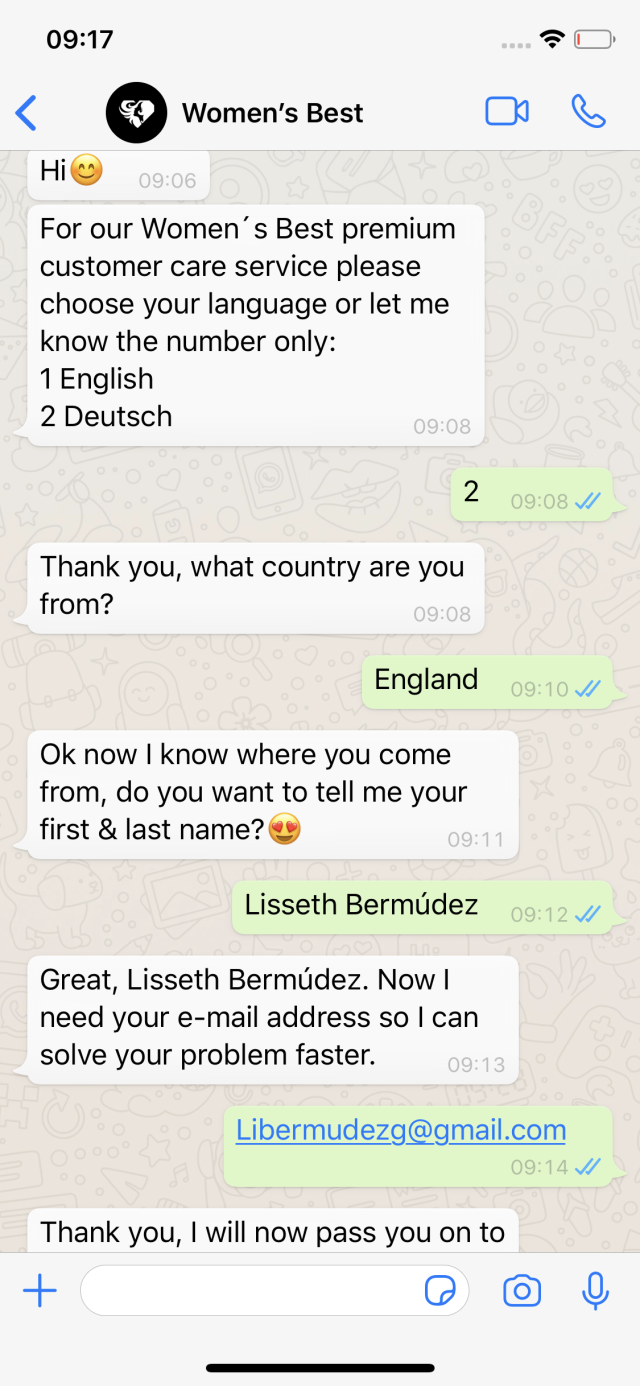In this article:
- Definition of "conversational commerce"
- What is the difference between conversational commerce and social commerce?
- The evolution of conversational commerce
- What channels are used for conversational commerce?
- Voice assistants
- Why is conversational becoming so important for businesses?
- These are the benefits of conversational commerce for your business
- Examples of conversational commerce
- Wrapping up: e-commerce becomes c-commerce
- Your software for conversational
Many experts are talking about the beginning of the conversational era, or the "age of conversational". Conversational marketing, conversational commerce, and conversational shopping are often used as terms in this context. However, what do we mean by "conversational", what role do messaging apps like WhatsApp or voice assistants like Alexa play in this, and where is this trend headed? An overview!
You've probably heard the term "conversational" in the context of voice assistants, such as Alexa or Siri. Apart from verbal conversation, the written word, for example, a chat via WhatsApp or with a ChatGPT, also counts as conversational interaction. And it is precisely this type of dialogue-based digital conversation that is becoming increasingly important for e-commerce.
In this guide, we'll look at why that is, how conversational e-commerce works, and why it is relevant for companies.
Definition of "conversational commerce"
The term "conversational commerce" has been around since 2015. It was UX expert, Chris Messina, who has worked for Uber and Google, who first floated the phrase in a blog post.
In it, Messina defines c-commerce as follows:
Conversational commerce is about delivering convenience, personalization, and decision support while people are on the go, with only partial attention to spare.
Conversational commerce emerges thus at the intersection between shopping and conversation. It is important that to note that the idea of "conversational" is for the exchange between customer and company to be dialogue-based. It is therefore not a one-way communication from the companies to the customers like an ad banner, but a two-way exchange.
Whereas typical advertising messages sound like: "Buy this, buy that!"; conversational commerce sounds more like: "What do you need today and how can I help you find it quickly and easily?" This approach doesn't only sound more pleasant and customer-friendly, it actually is!
Surveys among consumers show:
- 91% of consumers want help in real-time
- Live chats can increase conversion rates by up to 82%
- more than one billion users contact companies on messenger apps every week
This is precisely why experts and companies believe that c-commerce is the future of customer communication.
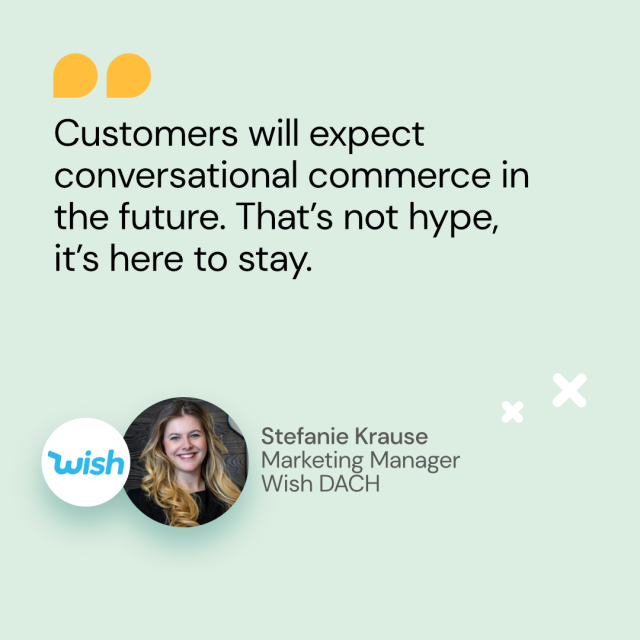
What is the difference between conversational commerce and social commerce?
Social commerce could be described as the predecessor of conversational commerce. It was the first attempt by companies to make the sales process more engaging and dialogue-based, via social media.
With about 50% of consumers learning about new brands on social media channels, it was only logical to continue the shopping experience right there. Social networks such as Instagram or Pinterest also recognized the trend and enabled direct shopping with store features or even live shopping options: social commerce was born.
In social commerce, the entire purchasing process, from discovering a product and asking questions about it to selling and paying for it, takes place on a social network.
Conversational commerce takes this concept one step further. Because, as convenient as it is to see a fancy sneaker on Instagram, click on the image, and then end up directly in the store to buy the shoe: there are still questions that come up.
"Does the shoe come in a different size?" "When will my favorite color be back in stock?" If these questions can't be answered, the social commerce experience is of little value, resulting in abandoned shopping carts, and a poor user experience once again.
This is exactly the gap that conversational commerce can fill, either by moving the conversation to messenger channels or by integrating chatbots that answer these questions. And it is this evolution of the digital shopping experience into a dialog that brings the best successes.
Online paint retailer MissPompadour, for example, sees conversational commerce as the real revenue driver, says Erik Reintjes, co-founder and CEO of MissPompadour.
Social media is the customer catcher. In WhatsApp, we convert the customers.
The success speaks for itself. Nine out of ten WhatsApp conversations lead to a purchase at MissPompadour!
Sidebar: conversational marketing
If social commerce is a shopping experience on social networks and conversational commerce is dialogue-based selling on digital channels — what is conversational marketing? It refers to the practice of combining content marketing and dialogue-based marketing through (automated) chats on WhatsApp and other messenger apps. Companies that manage to convey the idea of service and dialogue in messaging marketing campaigns are rewarded with high engagement!

The evolution of conversational commerce
The corner store is conversational commerce 1.0
Today, conversational commerce usually refers to a digital exchange, such as online shopping or e-commerce. In theory, however, every sales conversation between customers and companies falls under the definition of c-commerce and is thus actually as old as the exchange of goods and products.
If companies wanted to sell goods in the past, they had to go to the market or visit customers directly in order to sell them something. The sales were inherently conversational!
The corner store is another example or this: it's close, but also personal, and by the third visit, the owner already knew your favorite chocolate. That's why the neighborhood store didn't have to fear any competition; the customers kept coming back. But the corner store also had disadvantages. At night, on weekends, and in case of illness, the store remained closed, and it also had a limited offer.
From corner store to online store
With the rise of the internet, businesses like the corner store eventually moved to online platforms. Customers could now make purchases via web stores or apps. However, this concept was never particularly refined. Because this type of online shopping meant that customers had to do everything on their own throughout the entire customer journey.
They had to search for information, compare prices, or check delivery times. The only service that online stores or apps provided was the final purchase. However, if you are doing business this way, you only sell based on price—a battle that no retailer can survive in the long run!
Modern online shopping is therefore more than just being able to place orders 24/7. Today, product advice and customer service also have to happen in real time to satisfy customers. And in order to make this happen, what could be more appealing than shifting customer communication to digital channels that offer a user-friendly customer experience and are popular with end customers?!

What channels are used for conversational commerce?
Because c-commerce is conversational, it takes place on the channels that excel at enabling a smooth conversation between businesses and buyers: messaging apps, chatbots, and voice assistants.
WhatsApp, Telegram, iMessage, etc.: the next stage in c-commerce
Messenger services like WhatsApp, Telegram, or iMessage are dialogue channels! Their basic purpose is to enable conversations via chat. In addition, their multimedia features such as videos, photos, or voice messages make for an enhanced user experience (especially compared to the one-dimensional SMS)
In Europe, messenger apps are just being established as a dialogue channel between companies and customers. For countries, like the UK, Spain or Germany, WhatsApp is the most popular messaging app, and users can definitely imagine combining messaging and online shopping.
If you look at Brazil, India, and China — markets that started their digitalization much later than Europe or North America, you can see very quickly that they have already jumped over the stages of shopping on apps and websites, and went straight to shopping on messaging apps. There is a reason why WhatsApp just launched their very first end-to-end shopping experience in India!
While in China nothing works without the mega app WeChat (a messenger on which you can also shop, order a cab and pay), many companies in growing markets such as Brazil or India are already heavily using WhatsApp. The advantages are obvious:
- The app is already installed in millions of phones and largely used
- Businesses do not have to develop their own apps or host servers
- Once the customer has contacted the retailer via WhatsApp, the purchase rate is extremely high.
We deliberately didn't build a consumer website, just like we didn't build an app! The idea behind 'Threads' is curation and convenience. It's a customer-centric business and our customers prefer to communicate on messaging apps.
Sophie Hill, founder and CEO of Threads
From corner store to online store: messaging apps unite the best of both worlds! They offer:
- a two-way communication for the best customer service
- recognition of users and their preferences
- open 24/7, on 365 days a year
- available anytime, any place
With these developments, it's no surprise that Meta has just announced the age of conversational, and is deliberately promoting conversational commerce via new features such as end-to-end shopping on WhatsApp or direct payment in Instagram Direct.
Chatbots
Chatbots are also a good channel for conversational commerce. As automated chat assistants, they can often provide help faster than human agents and thus answer questions and help customers shop.
Companies often shy away from introducing chatbots. They fear that they could have a deterrent effect on customers, but the opposite is the case. In fact, the vast majority of consumers appreciate the constant availability and speed of chatbots.
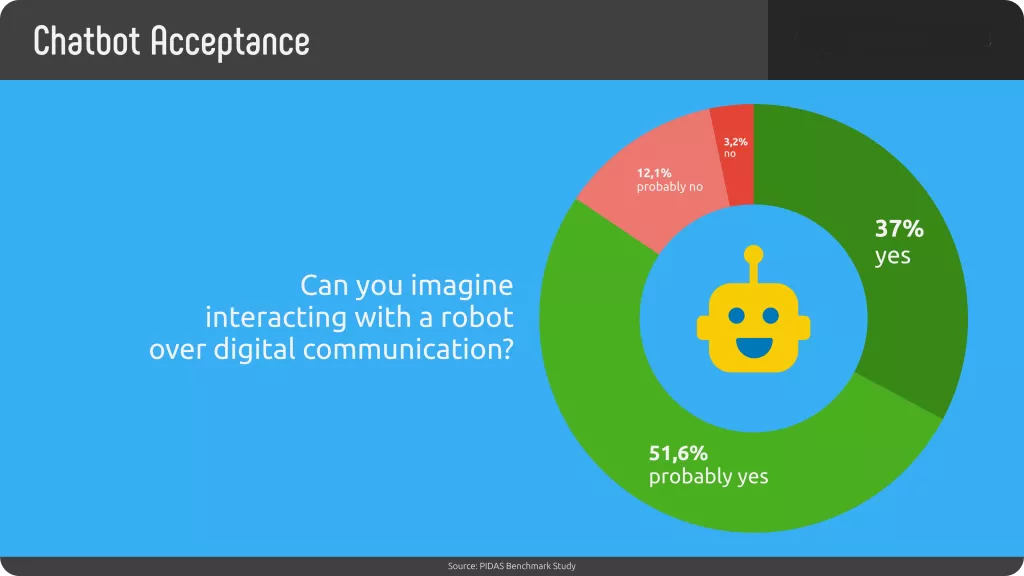
However, chatbots also offer many advantages for companies, especially in e-commerce.
- They relieve the service team (and provide 24-hour availability).
- Chatbots can access CRM systems to personalize the customer experience.
- In doing so, they improve the customer experience, and increase sales.
Furthermore, chatbots and messaging apps can be a wonderful combination to get the best out of both channels.

Voice assistants
Voice assistants are actually chatbots, too. However, they use speech instead of text to communicate with people. Well-known voice assistants are Alexa, Google Home, or Siri. These virtual assistants make dialogue-based shopping especially easy. Questions, such as "Alexa, where can I buy milk right now?" are the ideal stepping stone to conversational commerce.
In many companies, the technology is not yet very well-developed, even though the trend is clearly moving toward voice bots. Yet, some first movers, such as Sinch Chatlayer, are already offering very good solutions.
Why is conversational becoming so important for businesses?
There are five major trends that are pushing the importance of conversational for businesses:
- Rise of e-commerce
- Improvement in artificial intelligence
- Growing popularity of voice assistants
- End of tracking cookies
- Customers that are frustrated with their current shopping experience
1. The rise of e-commerce
E-commerce has been on the rise since before the Covid-19 pandemic, but the pandemic has sped up the trend. In the US, e-commerce revenue hovered around 515 billion US dollars in 2019. In 2020, it was around 644 billion, and it's expected to reach 872 in 20200.
As more people are shopping online, more consumers are looking for a smoother and more personable online shopping experience. And that's exactly what c-commerce can offer!
2. Advances in artificial intelligence
Conversational technologies such as chatbots or voice assistants only offer a good user experience if they are of high quality. Here, virtual assistants have made a huge leap forward in recent years thanks to technological advances in artificial intelligence.
Even simple chatbots can now answer almost 90% of all frequent customer inquiries in some companies and thus provide competent help faster, reduce the workload for service teams, and save money in the process.

As chatbots are getting smarter, they push dialogue-based e-commerce.
3. The rising popularity of voice assistants
The same applies to voice assistants. What is interesting here is that consumers are increasingly embracing this technology. In the US and the UK, almost 30% of consumers use the technology at least once a day.

Voice assistants are already dialogue-based by design. From saying, "Siri, play my after-work playlist!" to: "Alexa, can you buy some flowers, and have them sent to my mom!" is only a small step. As soon as e-commerce and voice assistants become more integrated, this convenient form of dialogue-based shopping will also become more popular.
4. The end of tracking cookies
Tracking cookies were long considered the most important method to collect data on customer behavior in e-commerce. What ends up in the shopping cart? Where did the users come from? Which products did they look at?
However, with the increasing tracking limitations of browsers such as Chrome, Firefox, and Safari, and a growing number of internet users opting out of tracking, cookies are providing less relevant data for businesses.
Therefore, direct data, meaning information that companies receive directly from customers, is becoming more significant. At the same time, this data is also much more reliable and therefore more relevant. And customer conversations are the best way to obtain this information. This is also fueling the trend of c-commerce.
5. Customers are frustrated with their current shopping experience
Many customers find their current online shopping experience frustrating. They don't get help quickly enough, have to search endlessly for information, and they also miss the personal approach. A global survey by Contentsquare indicates that only 15% of respondents are happy with their current online shopping experience.
Some of the frustrations are an impersonal shopping experience, and missing help. A conversational approach can improve this, and smart companies will start switching to conversational commerce.
These are the benefits of conversational commerce for your business
C-commerce expands the e-commerce target group!
According to the Digital 2022 global report, the most active e-commerce shoppers are between 25 and 54 years old, and even consumers 55 and older are avid online shoppers. This is exciting because this older target group no longer uses social media — but is on messaging apps like the Facebook Messenger, Telegram, or WhatsApp. Messaging apps can therefore be used to win over completely new target groups for conversational shopping!
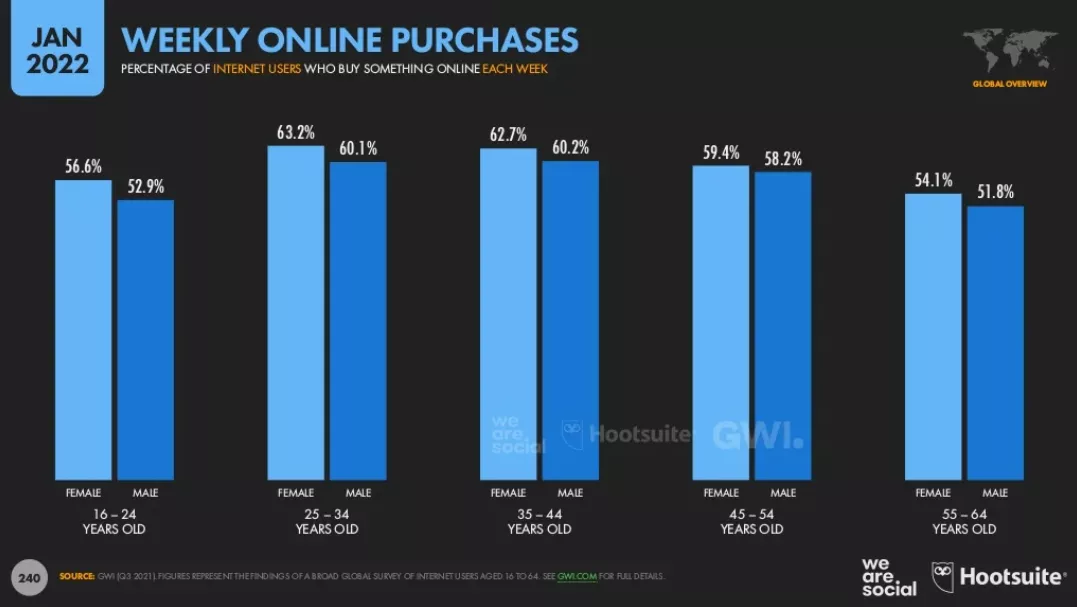
Provide better customer experience and increase loyalty
A conversation at eye level offers a better customer experience. For around 50% of all e-commerce customers, quick and detailed answers are the most important criteria for a positive experience. Messenger services, especially in combination with chatbots, can offer both, and thus improve customer satisfaction.
Also: satisfied customers buy again and recommend to others!
The success criterion for our WhatsApp service is the personal level. When we send the link, people also buy.
Erik Reintjes, co-founder and CEO of MissPomupadour
Get more valuable customer information
Since conversational commerce offers more valuable customer data than tracking tools, companies can gain better insights into customer preferences. This can improve offerings, fix bugs faster, and make the customer experience more enjoyable.
Because c-commerce focuses on interactions with customers, it's also the ideal way to improve the customer experience.
With channels like Whatsapp, we see a very high level of customer satisfaction
Thomas Koch CEO of E WIE EINFACH
Receive better feedback
Conversational selling provides better feedback. For example, as already mentioned, direct customer data provides valuable insights into customer behavior. At the same time, it is easier to ask for feedback while you are talking to someone. If you're chating with customers already, it's simple to ask for a feedback at the end.
In the chat, companies can also incorporate automated rating functions. Sportstech, an online company that sells fitness equipment, uses a rating bot, for example.
The bot first asks whether the person was satisfied. If the feedback is one to three stars, the bot offers to contact customer service. With four or five stars, the bot asks for a rating on a platform such as Amazon.
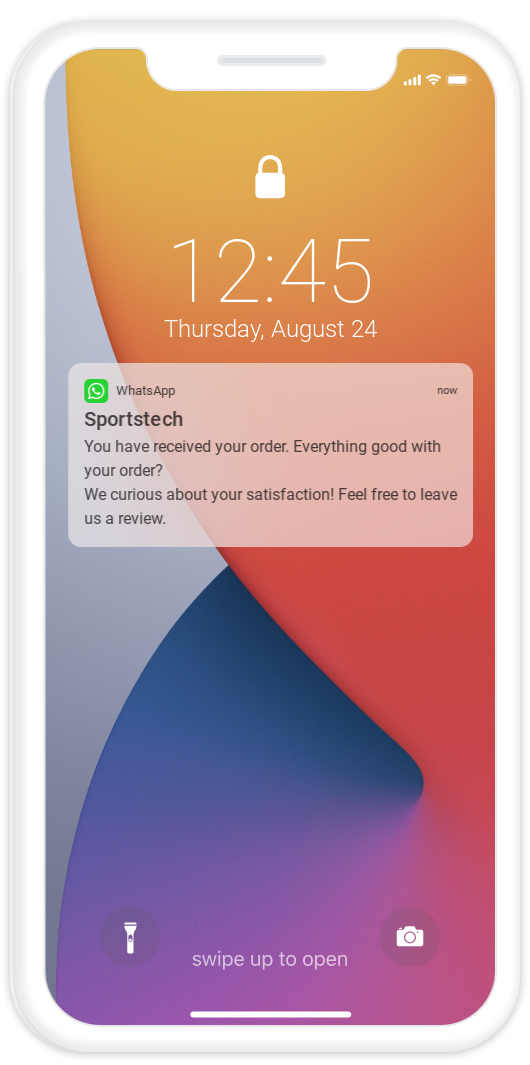
Reduce costs
C-commerce via WhatsApp, Instagram Direct or the Messenger on Facebook can reduce costs. As you can integrate automation tools like chatbots, you can use FAQ bots to answer some of the most common customer questions, and reduce the number or hours of call center agents.
Companies can also reduce their customer acquisition costs. Since the more personal exchange on messaging apps creates a higher level of loyalty, and you don't have to "buy" users again and again by placing ads like on Instagram or Google, you can make significant savings! It is also much easier to reactivate existing contacts with marketing notifications on messaging apps, for example.
Those who use c-commerce on messaging apps can offer the entire customer journey on one channel. There is no need to set up one channel for ads, another one for product information, and yet another one for customer support. It can all happen within the messaging app!
With a professional messaging software, you can integrate several messaging apps in one platform and manage the entire process centrally on one dashboard.

Increase sales
Conversational channels like WhatsApp are the better sales channels. Customers can get their questions answered directly, which leads to fewer cancelled orders and fewer abandoned shopping carts. The current rate of abandoned shopping carts is 70%! This means that WhatsApp and co. offer huge potential to increase sales.
Examples of conversational commerce
Wish: Shopping inspiration through a WhatsApp chatbot
The quirky e-commerce company Wish has a very conversational approach to online shopping. They invite potential customers to start a chat with them on WhatsApp. Here, a chatbot takes over, asks a few basic questions, and then sends shopping suggestions.
This shopping assistant is hugely popular with customers, and they end up looking at nine different products on average per chat — a great engagement rate!
Women's Best
Women's Best is a successful social media start-up that specializes in sport products, and uses conversational channels to sell them. The brand receives over 1,000 orders on several messaging apps per day.
With the help of Sinch Engage, Women's best is now able to channel inquiries from WhatsApp and Apple Messages for Business on one platform, and process incoming requests and orders faster. Especially for their digital target, messaging apps are the perfect shopping channel.
Women's Best combines a first-level chatbot that they use to gather general information, after which customers are forwarded to a personal shopping assistant.
Wrapping up: e-commerce becomes c-commerce
In the past years, digital communication is moving away from computers and to conversational channels like voice assistants, chatbots, and messenger services!
The entire customer communication is also becoming more conversational again, but with a larger focus on digital channels and automated solutions.
Companies that are focused on customer satisfaction, lead generation, or improving customer retention (basically, any company out there that wants to be a successful business!), won't get around conversational commerce.
Your software for conversational
When it comes to how you can use conversational strategies in your business, Sinch Engage offers a scalable, ready-to-go solution. With the tool, you can start conversing with your customers on the most popular messenger apps like WhatsApp, Instagram Direct, Apple Messages for Business, the Facebook Messenger, Viber, Notify, or Telegram, and even integrate chatbots-all from one central interface.





